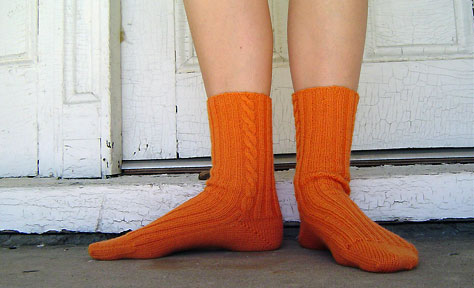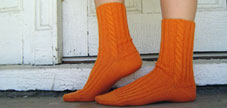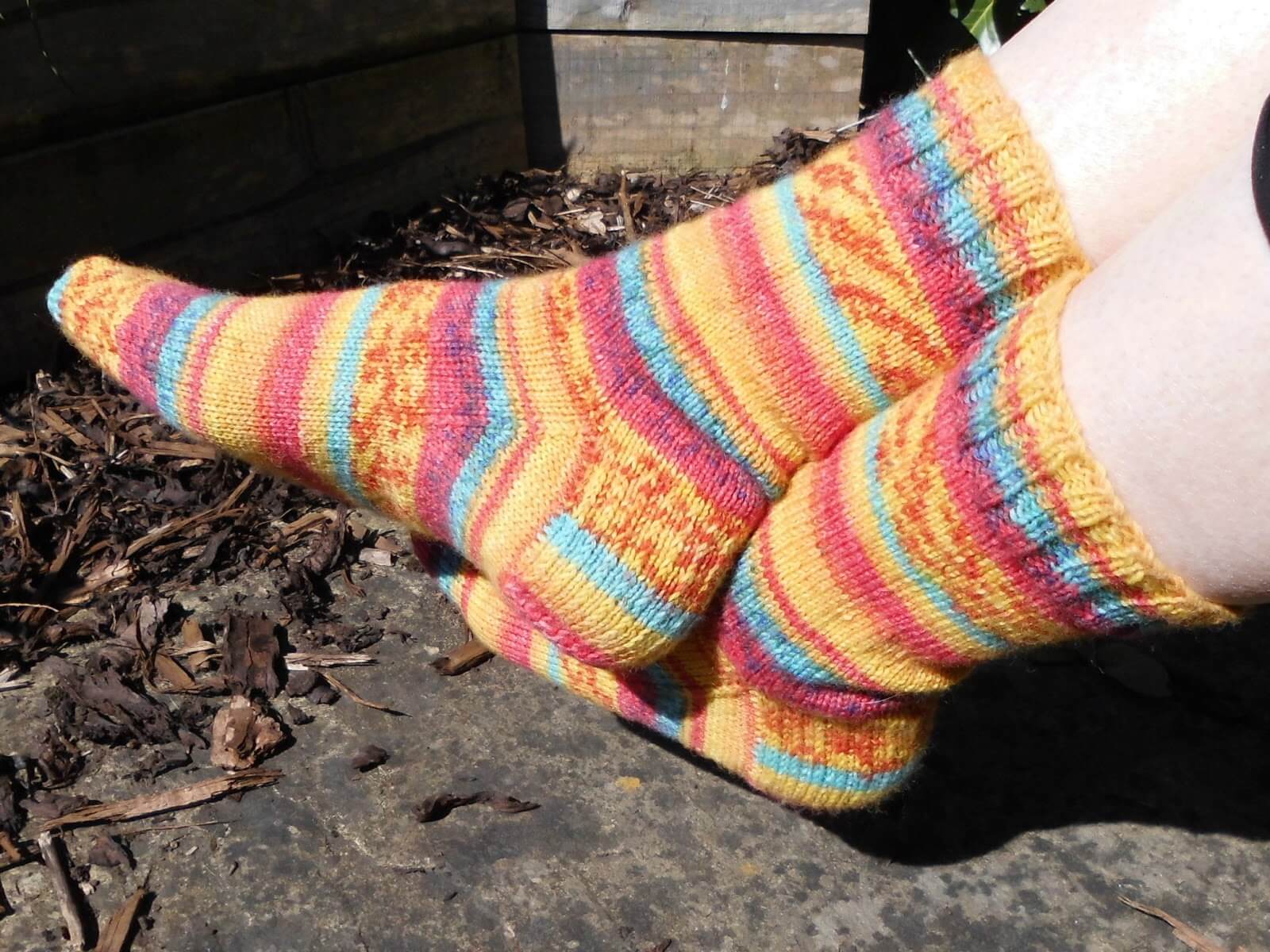Melodi
Disaster Cat
OK, this is an old one, and personally, I think most beginners might want a pattern with even larger needles and a cast on of 40 but this is close at 52 stitches. This one doesn't have any pictures or anything but looks to be a good basic pattern but I haven't made it. This should work with either worsted weight yarn and with anything from the suggested size 3.5 needles to US 5s, depending on how loose or tight you knit.
BRIGGS & LITTLE'S HEAVY SOCK PATTERN
ADULT SIZE
Adult Size 10: Length of leg -- 11 inches (28 cm)
Length of foot between toe and heel -- 8 inches (20 cm)
Note: Lengths of legs and feet may be adjusted but
increases may require more yarn.
Yarn: 2 - 4 oz.( 113 gm) skeins of Briggs & Little 100% Wool Yarn
2/8, 2 ply or Homespun Style
1 - 4 oz. (113 gm) skein of same for contrast stripe if desired
[Note: Suitable yarns for substitution are heavy worsted weight yarns,
which would normally knit to a gauge of 4-4.5 sts on size 5 or 5.5 mm
needles (American sizes 8 or 9).]
Needles: 1 set double pointed 3.25 mm (American size 3)
Tension: To be measured on 3.25 needles in stocking stitch
12 sts and 16 rows = 2 inches (5 cm)
If you do not obtain the correct tension, use larger or smaller
needles as indicated.
CHECK YOUR TENSION. A careful check to your tension is the only assurance
you have of a proper size for the finished garment. Your test piece should
be large enough so it can be laid out without being stretched or
compressed by the needles.
ADULT SOCK
Cast on 54 sts. 18 on each of 3 needles. Join. Rib (K2, P1) around. Rib
six rows around in main color; rib six rows around in contrasting color;
rib six rows around in main color; rib six rows around in contrast color.
Continue rib in main color until leg measures 11 ins. or desired length.
TO MAKE A HEEL
Turn work and P 27 sts on 1 needles. Divide remaining sts on 2 needles
(14 and 13). Do not work these sts.
Working on needle with 27 sts. Turn.
Row 1: K1, Sl1 across row ending in K sts. Turn.
Row 2: P across row. Turn.
Repeat: Rows 1 and 2 until work measures 3 inches ending with a P row.
TO TURN HEEL
Row 1: K1, Sl1 for 17 sts. Then Sl1, K1, PSSO. Turn.
Row 2: Sl1, P7, P2 tog. Turn.
Row 3: (Sl1, K1) 4 times, Sl1, K1, PSSO. Turn.
Repeat: Rows 2 and 3 until 9 sts remain. Turn.
TO MAKE INSTEP
K across 9 sts, then pick up and K 15 sts along side of heel. Place 27 sts
divides at start of heel on one needles (front of sock) and rib (K2, P1)
as before. With other needle pick up and K 15 sts from other side of
heel. K5 sts from heel needle on this needle, making 20 sts on 1st needle,
27 on 2nd or front needle, and 19 sts on 3rd needle.
Row 1: K 1st needle, Rib 2nd needle, K 3rd needle.
Row 2: 1st needle: K to last 3 sts, K2 tog, K1
2nd needle: Rib
3rd needle, K1, Sl1, K1, PSSO, K to end of needle.
Repeat these two rows until 13 sts remain on 1st needle and 12 sts on 3rd
needle. Continue knitting, keeping rib on 2nd or front needle until foot
measures 8 inches from back of heel, ending 3rd needle.
TO SHAPE TOE
Sl1 from front needle to 3rd needle making 13 sts on each side needle and
26 sts on front needle.
Row 1: 1st needle: K to last 3 sts, K2 tog, k1
2nd needle: (Do not rib when shaping toe)
K1, Sl1, K1, PSSO, K to last 3 sts, K2 tog, K1
3rd needle: K1, Sl1, K1, PSSO, K to end of needle.
Row 2: K around all 3 needles.
Repeat these 2 rows until 4 sts remain on 1st needle, 8 sts on 2nd needle
and 4 sts on 3rd needle (16 sts in total). With 3rd needle K the 4 sts
from 1st needle leaving 8 sts on each of 2 needles. Break off yarn about
18 inches long and thread through darning needle to weave or graft toe.
Copyright 1995 Briggs & Little Woolen Mills Ltd. This pattern may be
freely shared and distributed in any medium so long as it remains fully
intact, including this copyright notice, and no profit is made from its
use or distribution. A special thanks is extended to John Little for letting
the "troop knitting" effort make use of this pattern.
Esther S. Bozak
ebozak@cs.oswego.edu
URL: BRIGGS & LITTLE'S HEAVY SOCK PATTERN
BRIGGS & LITTLE'S HEAVY SOCK PATTERN
ADULT SIZE
Adult Size 10: Length of leg -- 11 inches (28 cm)
Length of foot between toe and heel -- 8 inches (20 cm)
Note: Lengths of legs and feet may be adjusted but
increases may require more yarn.
Yarn: 2 - 4 oz.( 113 gm) skeins of Briggs & Little 100% Wool Yarn
2/8, 2 ply or Homespun Style
1 - 4 oz. (113 gm) skein of same for contrast stripe if desired
[Note: Suitable yarns for substitution are heavy worsted weight yarns,
which would normally knit to a gauge of 4-4.5 sts on size 5 or 5.5 mm
needles (American sizes 8 or 9).]
Needles: 1 set double pointed 3.25 mm (American size 3)
Tension: To be measured on 3.25 needles in stocking stitch
12 sts and 16 rows = 2 inches (5 cm)
If you do not obtain the correct tension, use larger or smaller
needles as indicated.
CHECK YOUR TENSION. A careful check to your tension is the only assurance
you have of a proper size for the finished garment. Your test piece should
be large enough so it can be laid out without being stretched or
compressed by the needles.
ADULT SOCK
Cast on 54 sts. 18 on each of 3 needles. Join. Rib (K2, P1) around. Rib
six rows around in main color; rib six rows around in contrasting color;
rib six rows around in main color; rib six rows around in contrast color.
Continue rib in main color until leg measures 11 ins. or desired length.
TO MAKE A HEEL
Turn work and P 27 sts on 1 needles. Divide remaining sts on 2 needles
(14 and 13). Do not work these sts.
Working on needle with 27 sts. Turn.
Row 1: K1, Sl1 across row ending in K sts. Turn.
Row 2: P across row. Turn.
Repeat: Rows 1 and 2 until work measures 3 inches ending with a P row.
TO TURN HEEL
Row 1: K1, Sl1 for 17 sts. Then Sl1, K1, PSSO. Turn.
Row 2: Sl1, P7, P2 tog. Turn.
Row 3: (Sl1, K1) 4 times, Sl1, K1, PSSO. Turn.
Repeat: Rows 2 and 3 until 9 sts remain. Turn.
TO MAKE INSTEP
K across 9 sts, then pick up and K 15 sts along side of heel. Place 27 sts
divides at start of heel on one needles (front of sock) and rib (K2, P1)
as before. With other needle pick up and K 15 sts from other side of
heel. K5 sts from heel needle on this needle, making 20 sts on 1st needle,
27 on 2nd or front needle, and 19 sts on 3rd needle.
Row 1: K 1st needle, Rib 2nd needle, K 3rd needle.
Row 2: 1st needle: K to last 3 sts, K2 tog, K1
2nd needle: Rib
3rd needle, K1, Sl1, K1, PSSO, K to end of needle.
Repeat these two rows until 13 sts remain on 1st needle and 12 sts on 3rd
needle. Continue knitting, keeping rib on 2nd or front needle until foot
measures 8 inches from back of heel, ending 3rd needle.
TO SHAPE TOE
Sl1 from front needle to 3rd needle making 13 sts on each side needle and
26 sts on front needle.
Row 1: 1st needle: K to last 3 sts, K2 tog, k1
2nd needle: (Do not rib when shaping toe)
K1, Sl1, K1, PSSO, K to last 3 sts, K2 tog, K1
3rd needle: K1, Sl1, K1, PSSO, K to end of needle.
Row 2: K around all 3 needles.
Repeat these 2 rows until 4 sts remain on 1st needle, 8 sts on 2nd needle
and 4 sts on 3rd needle (16 sts in total). With 3rd needle K the 4 sts
from 1st needle leaving 8 sts on each of 2 needles. Break off yarn about
18 inches long and thread through darning needle to weave or graft toe.
Copyright 1995 Briggs & Little Woolen Mills Ltd. This pattern may be
freely shared and distributed in any medium so long as it remains fully
intact, including this copyright notice, and no profit is made from its
use or distribution. A special thanks is extended to John Little for letting
the "troop knitting" effort make use of this pattern.
Esther S. Bozak
ebozak@cs.oswego.edu
URL: BRIGGS & LITTLE'S HEAVY SOCK PATTERN








